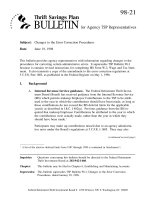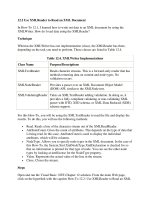Tài liệu 98-21: Changes to the Error Correction Procedures ppt
Bạn đang xem bản rút gọn của tài liệu. Xem và tải ngay bản đầy đủ của tài liệu tại đây (47.18 KB, 11 trang )
-1-
●●
●●
●
98-21
BULLETIN
for Agency TSP Representatives
Thrift Savings Plan
●●
●●
●
Federal Retirement Thrift Investment Board
1250 H Street, NW Washington, DC 20005
Subject: Changes to the Error Correction Procedures
Date June 19, 1998
Inquiries: Questions concerning this bulletin should be directed to the Federal Retirement
Thrift Investment Board at 202-942-1460.
Chapter: This bulletin may be filed in Chapter 6, Establishing and Maintaining Accounts.
Supersedes: This bulletin supersedes TSP Bulletin 98-3, Changes to the Error Correction
Procedures, dated January 29, 1998.
(continued on next page)
This bulletin provides agency representatives with information regarding changes to the
procedures for correcting certain administrative errors. It supersedes TSP Bulletin 98-3
because it contains revised instructions for completing IRS Form W-2, Wage and Tax State-
ment. It also transmits a copy of the amendment to the error correction regulations at
5 C.F.R. Part 1605, as published in the Federal Register on May 1, 1998.
I. Background
A. Internal Revenue Service guidance. The Federal Retirement Thrift Invest-
ment Board (Board) has received guidance from the Internal Revenue Service
(IRS) which permits makeup Employee Contributions to the TSP to be attrib-
uted to the year in which the contributions should have been made, as long as
these contributions do not exceed the IRS deferral limits for the applicable
year(s) as described in I.R.C. § 402(g). Previous guidance from the IRS re-
quired that makeup Employee Contributions be attributed to the year in which
the contributions were actually made, rather than the year in which they
should have been made.
1
Participants may make up contributions missed due to an agency administra-
tive error under the Board’s regulations at 5 C.F.R. § 1605. They may also
1
A list of the elective deferral limits from 1987 through 1998 is contained in Attachment 1.
-2-
make up missed contributions due to military service under the Uniformed
Services Employment and Reemployment Rights Act (USERRA) and the Board’s
regulations at 5 C.F.R. § 1620.
B. Program Changes. In order to implement the new IRS guidance, agency
representatives will need to make several changes to the way makeup contri-
butions for prior years are submitted to the TSP record keeper. Up until the
present time, the accumulation of Employee Contributions in the TSP System
was based on the year in which the contributions were actually made, rather
than the year to which the contributions were attributable. As a result, when
previous makeup contributions were made to a participant’s TSP account, the
cumulative amount of Employee Contributions in the TSP System might not
accurately reflect the contributions for the attributable years.
To ensure that all valid contributions are processed, a new Journal Voucher
(JV) has been developed. Agency payroll offices will use the new JV when
previous makeup contributions have been processed and the reported Em-
ployee Contributions will cause the participant’s account, as recorded in the
TSP System, to exceed the elective deferral limit. (See Section IV below for
more information).
II. Current Procedures for Reporting Makeup Employee Contributions
Attributable to a Prior Year and Late Contributions
A. Makeup contributions
1. Makeup Employee Contributions are retroactive contributions being de-
ducted from a participant’s current pay or back pay award. They are gen-
erally submitted with routine contributions on a Current Payment Record
(11-Record).
2. These contributions are edited by the TSP System against the annual elec-
tive deferral limit ($10,000 for 1998) based on the effective date on the
Current Payment Record (11-Record). If the amount of Employee Contri-
butions on the Current Payment Record (11-Record), when added to the
Employee Contributions posted to the participant’s TSP account for the
same year, exceeds the elective deferral limit, the record is deleted by the
TSP System and the contributions are not processed.
B. Late contributions
1. When Employee Contributions that were previously deducted (and
agency contributions that were previously charged to the agency’s ac-
counting appropriation) are not timely reported to the TSP record keeper,
they are generally submitted on a Late Payment Record (41-Record). In
addition, contributions that were previously deleted and which must be
-3-
resubmitted to the TSP record keeper are required to be submitted on
Late Payment Records (41-Records) with the applicable pay date to which
the contributions relate.
2. When the TSP System receives a Late Payment Record (41-Record) that
contains Employee Contributions with an effective date that is earlier than
the prior year (e.g., an effective date in 1996 or earlier for a record edited
in 1998), the Employee Contributions are edited first against the elective
deferral limit for the year in which the effective date falls (based on that
year’s year-to-date Employee Contributions cumulative total). If the Late
Payment Record (41-Record) fails this edit, the record is deleted. If the
Late Payment Record (41-Record) passes this edit, the Employee Contribu-
tions are then edited against the elective deferral limit for the current year
(based on the current year’s year-to-date Employee Contributions cumula-
tive total). If the Late Payment Record (41-Record) also passes this edit,
the effective date of the record is changed to the “date payroll paid” from
the Journal Voucher. The Late Payment Record (41-Record) is then
posted to the participant’s TSP account with the current year’s effective
date.
III. Revised Procedures for Reporting Makeup Employee Contributions
Attributable to a Prior Year
A. Makeup contributions
1. The revised procedures require agency payroll offices to report makeup
Employee Contributions attributable to a prior year on Late Payment
Records (41-Records). Makeup Employee Contributions that are at-
tributable to a prior year can no longer be submitted with routine
contributions on a Current Payment Record (11-Record).
These makeup contributions include makeup contributions required be-
cause of an agency’s failure to deduct the proper amount of Employee
Contributions, makeup contributions required as a result of a back pay
award or other retroactive pay adjustment, makeup contributions required
due to a retirement coverage error, and makeup contributions required
under USERRA.
2. The effective date reported on each Late Payment Record (41-Record) is
the pay date to which the contributions are attributable, rather than the
pay date on which the contributions are actually made.
3. Makeup Employee Contributions that are attributable to the current year,
however, can continue to be submitted with routine Employee Contribu-
tions on a Current Payment Record (11-Record). They can also be sub-
mitted on a Late Payment Record (41-Record) with the attributable pay
date.
-4-
4. The TSP System will edit all Employee Contributions against the elective
deferral limit only for the year reported on Current Payment Records
(11-Records) and on Late Payment Records (41-Records).
B. Late contributions. There are no changes to the procedures for reporting
late contributions. However, the TSP System will edit Employee Contributions
only against the year reported on the Late Payment Record (41-Record).
IV. New Certification Process
A. New Journal Voucher. A new Journal Voucher, Form TSP-2-I, Certification
That the IRS Annual Elective Deferral Limit Is Not Exceeded and Journal
Voucher, has been created to ensure that all valid contributions are processed.
(See Attachment 2.)
1. This special JV is to be used exclusively for submitting those contributions
that have been (or would be) deleted by the TSP System because the cu-
mulative amount of year-to-date Employee Contributions for the appli-
cable year is not correct in the TSP System. This is because previous
makeup Employee Contributions were processed based on the year in
which the contributions were actually made, rather than the year in which
the contributions should have been made. Consequently, if the makeup
contributions, when added to the previous contributions made for the ap-
plicable year, would cause contributions to be deleted by the TSP System,
Form TSP-2-I should be used to submit the makeup contributions on Late
Payment Records (41-Records).
2. Form TSP-2-I is not to be used for regular payroll submissions or the sub-
mission of other makeup contributions.
3. In cases where previous makeup contributions have been submitted to
the TSP record keeper for a participant, the agency payroll office is en-
couraged to contact the TSP Operations Office at 504-255-5110 before
submitting makeup contributions for a prior year.
B. Resubmission of deleted records
1. If an agency payroll office has submitted makeup Employee Contributions
for a participant which are attributable to a prior year using the previous
error correction procedures, the cumulative year-to-date contributions for
that year and the year in which the contributions were posted to the
participant’s account will not be correct in the TSP System. Consequently,
the TSP System may delete a Current Payment Record (11-Record) or a
Late Payment Record (41-Record) because, according to the records
posted for that account, that record will cause the elective deferral limit
-5-
for the applicable year to be exceeded. In this case, the agency payroll
office should immediately resubmit those contributions on a Late Payment
Record (41-Record) if, based on the agency’s payroll records, the contri-
bution does not cause the participant’s total contributions to exceed the
elective deferral limit for the applicable year.
2. The Late Payment Records (41-Records) must be accompanied by Form
TSP-2-I to certify that the amounts submitted do not cause the partici-
pant’s total contributions to exceed the elective deferral limit for the
year(s) reported on the Late Payment Records (41-Records) as reflected
in the agency’s payroll system.
3. Contributions that are deleted because they exceed the annual elective
deferral limit will be closely monitored by the TSP record keeper to en-
sure that contributions are being processed correctly.
V. Agency Instructions on Completing IRS Form W-2, Wage and Tax
Statement, and Information Agencies Should Provide to Employees
A. IRS Form W-2. The IRS has advised the Board that its instructions for report-
ing makeup USERRA contributions, which are contained in its issuance 1998
Instructions for Form W-2, should also be used to report other TSP makeup
contributions that are attributable to prior years. Consequently, makeup Em-
ployee Contributions that are attributable to a prior year should continue to be
reported by the agency payroll office in Box 13 on the employee’s IRS Form
W-2, Wage and Tax Statement, as deferred income for the year in which the
makeup Employee Contributions were deducted from the employee’s pay-
check (or back pay award). However, in those cases where makeup Em-
ployee Contributions, when added to the routine Employee Contributions for
the current tax year, exceed the elective deferral limit for that year, the
makeup amounts should be reported separately along with the year to which
they are attributable.
Example: Assume that for 1998, a participant contributes $8,000 to the TSP.
In addition, because of a previous error that was made by the participant’s
employing agency, the participant makes up $2,000 which is attributable to
1993 and $1,000 which is attributable to 1994. Box 13 should include:
D 8000.00
D-1993-2000.00
D-1994-1000.00
(Because $8000 are contributions attributable to the current year, the year
need not be reported.)









